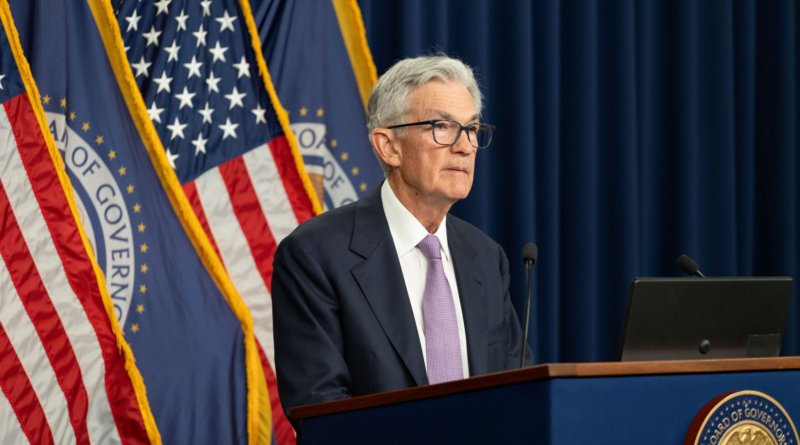Fed and peers will go ahead with rate cuts after this week’s US election
The Federal Reserve and many rich-world peers are widely expected to lower interest rates again in the coming week, right after a US presidential election that may not be decided yet.
Central banks responsible for more than a third of the global economy will set borrowing costs in the wake of the vote, clinging to whatever certainties they can discern on the likely path of American policy for the next four years.
With Vice President Kamala Harris and former President Donald Trump neck-and-neck before Election Day on Nov. 5, monetary officials from Washington to London may find themselves still in suspense.
Election aside, US policymakers have already communicated a desire to proceed with a more gradual pace of rate cuts after September’s half-point reduction. Economists widely expect a quarter-point move on Thursday, followed by another in December — and their conviction grew after data on Friday showed the weakest hiring since 2020.
Fed officials try to steer clear of politics, yet they kicked off a rate-cutting cycle heading into the final stretch of an election whose outcome may hinge on how voters feel about the economy. While Chair Jerome Powell will likely stress that the current conditions warrant less restrictive policy when he speaks after the decision, he and his colleagues still risk political backlash.
Central banking counterparts elsewhere are confronting a panoply of risks ranging from slowing economic growth to lingering inflation, even before they contemplate what sort of hit to global trade Trump’s threat of tariffs would effectively entail.
While the Reserve Bank of Australia will probably keep borrowing costs on hold again in a decision on Tuesday, hours before US polls open, other peers are poised to act. Those in the UK, Sweden, the Czech Republic and elswewhere are anticipated to cut rates in decisions after Election Day, while Brazilian officials may hike by as much as a half point.
With such a close-run presidential race, policymakers at the 20 or so central banks setting borrowing costs in the coming week may need to prepare for an extended wait until there’s a settled result. In modern US elections, the losing candidate generally concedes within a day or two, but the 2020 outcome wasn’t called until four days later.
Click here for what happened in the past week, and below is our wrap of what’s coming up in the global economy.
US and Canada
Apart from the Fed decision, data due in the US include the preliminary estimate of third-quarter productivity growth. Such gains have been robust recently as businesses invest in new technology and artificial intelligence, which could enable firms to raise wages without fanning inflation.
The Institute for Supply Management will also release its October report on the economy’s service sector. The University of Michigan is due later in the week to report consumer sentiment in early November, against a backdrop of an underlying labor market that continues to cool.
Turning to Canada, the labor force survey due for October will follow a surprisingly solid report in September that saw the jobless rate tick down to 6.5%.
The Bank of Canada nevertheless proceeded with a 50 basis-point cut on weak inflation and economic growth, and the fresh jobs data will offer insight into how the labor market is holding up.
The central bank will release a summary of deliberations that led to their jumbo-cut decision and Senior Deputy Governor Carolyn Rogers will speak at the Economic Club of Toronto.
- For more, read Bloomberg Economics’ full Week Ahead for the US
Asia
The week may start with some excitement in South Asia, where Pakistan’s central bank is likely to keep its monetary easing cycle moving at a quick pace with another 2-percentage-point cut, bringing its key rate to 15.5%.
The following day, Australian officials are expected to hold their cash rate target at 4.35% after consumer inflation stayed elevated in the three months through September, cementing notions that policymakers will have to wait before pivoting.
The RBA will also release a new round of economic forecasts that could shed light on the timing of a potential cut. Malaysia’s central bank is seen standing pat on its benchmark rate on Wednesday.
South Korea releases an update on inflation on Tuesday, with figures expected to show further easing, supporting the Bank of Korea’s policy pivot last month.
Consumer-price statistics are also due from the Philippines, Thailand, Vietnam and Taiwan. Japan publishes wage data that may keep the central bank on track for a rate hike late this year or early next, and trade data are due from China, Australia, Vietnam, Taiwan and the Philippines.
Countries publishing third-quarter gross domestic product data include the Philippines and Indonesia.
Finally, China releases key updates on price trends on Nov. 9, with the focus on whether consumer inflation continues to stagger along at a pace just north of zero, and factory-gate prices slide further, after declines deepened in the previous two months.
- For more, read Bloomberg Economics’ full Week Ahead for Asia
Europe, Middle East, Africa
The Bank of England decision on Thursday may draw particular attention, coming just after plans for higher borrowing and spending unveiled in the Labour government’s budget pushed UK borrowing costs to their highest in a year.
That tense backdrop isn’t anticipated to distract policymakers from further easing for now. They’re predicted by all 49 economists surveyed by Bloomberg to deliver a quarter-point rate cut on Thursday.
With the budget featuring a fiscal loosening, Bloomberg Economics reckons that quarterly forecasts accompanying the decision will probably show higher growth and medium-term inflation.
Turning to Sweden, expectations for the Riksbank have shifted decisively in favor of a half-point cut to 2.75% on Thursday, after data showed the economy remains in a holding pattern. Output shrank in the third quarter, and the country’s large export sector is becoming more pessimistic.
After almost three years of stagnation, Swedish officials may adopt a greater sense of urgency in aiding growth, especially as inflation has fallen below its 2% target and threatens to remain stuck there unless domestic demand picks up again.
On the same day, Norges Bank is expected to keep its rate at 4.5%, with renewed krone weakness likely to preserve its outlook for no easing until March next year.
Even with underlying inflation slowing, a currency drifting closer to multi-year lows is clouding projections for imported price growth. Norway’s ruling coalition has also drafted a budget for 2025 that’s more expansionary than expected by policymakers, adding to arguments for them to stay hawkish.
Here’s a quick roundup of other decisions expected from around the wider region:
- On Tuesday, Madagascar is set to increase its key rate for a second time in a row to tame double-digit inflation.
- Polish policymakers on Wednesday are widely expected to hold rates steady. But a new projection coupled with the latest string of disappointing data from the economy may prompt them to signal easing is on the way.
- In Botswana, encouraged by the slowest inflation in more than a year, officials are set to reduce their rate on Thursday, the first decision since a shock election outcome ended the Botswana Democratic Party’s 58-year grip on power in the major diamond producer.
- The Czech central bank will hold its rate-setting meeting the same day, with the market betting on another quarter-point rate cut.
- Serbian policymakers will decide between resuming monetary easing or holding rates for a second month, at a time when inflation seems safely back in the target range but risks persist from food and energy prices.
- And then on Friday, Romania’s central bank is expected to keep rates unchanged again at its final meeting of 2024. Officials are waiting for the government to reveal measures, potentially tax increases, to reduce a budget deficit before committing to any more rate cuts.
In the euro zone, industrial data are likely to prove a highlight, with numbers from France, Germany and Italy all scheduled. Several policymakers are slated to speak, including European Central Bank President Christine Lagarde, Vice President Luis de Guindos, and chief economist Philip Lane.
Turkish data on Monday will probably show inflation dipped slightly in October, to 48%. The central bank’s aim is to slow it to the 38% to 42% range by the end of the year, allowing it to start cutting the rate from its current level of 50%.
Later in the week, International Monetary Fund chief Kristalina Georgieva is expected to visit Cairo to discuss an $8 billion loan program.
Egypt has signaled it wants to review targets and timelines of the deal amid regional upheaval, with Houthi attacks in the Red Sea and the war in Gaza leading to reduced Suez Canal traffic and tourism revenue.
- For more, read Bloomberg Economics’ full Week Ahead for EMEA
Latin America
In Brazil, central bank chief Roberto Campos Neto’s warnings about unmoored inflation expectations, along with rising headline readings, has analysts looking for a half-point interest rate hike to 11.25% on Wednesday.
The early consensus also is for a third straight increase at the central bank’s December meeting.
Banco Central de Reserva del Perú will likely trim the nation’s borrowing costs by a quarter point, to 5%, with inflation running right around the mid-point of its 1%-to-3% target range.
Still, Peruvian policymakers, led by Julio Velarde, have delivered unexpected decisions at five of their last eight meetings, so another surprise is possible.
Colombia’s central bank serves up both its quarterly inflation report and the minutes of its Oct. 31 meeting, where policymakers made an eighth straight rate cut.
Analysts surveyed by the central bank expect 350 basis points of easing from the current 9.75% by the fourth quarter of 2025.
The week will also see Brazil, Mexico, Colombia and Chile report October consumer price data.
With Peru having already posted a higher print for October, it’s likely that of the region’s five big inflation-targeting central banks, only Colombia’s BanRep actually has inflation in retreat, and none have it at or below their targets.




